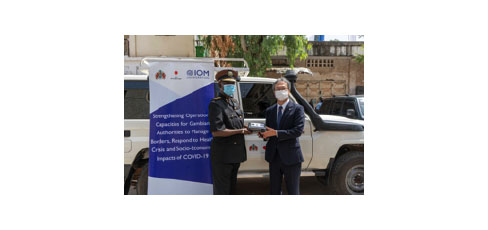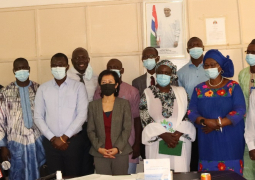
The donated equipment included items to strengthen document security, a Migration Information Data and Analysis System (MIDAS) mobile kit, and a brand-new Toyota Land Cruiser to support border patrol.
“This equipment will contribute to capacity building of Gambian administrations at all levels to perform smoothly their duties while assuring safe cross-border activities,” emphasized H.E. Ambassador Arai.
The Ambassador also toured the central server room of the MIDAS system, which is a user-friendly and customizable Border Management Information System (BMIS) with the capacity to collect, store and analyze traveler information in real time, in compliance with international standards.
With MIDAS installed at the GID Headquarters and in four border posts, the system allows the Government of The Gambia to have real-time information on movement across these four checkpoints, better facilitate cross-border movement and understand mobility patterns, which form the basis for planning migration-related policy. The Gambia is one of over 20 countries worldwide that has operationalized the use of MIDAS.
Furthermore, the visit served as an opportunity for the Ambassador to engage GID on the latest updates in border management interventions, funded by the Government of Japan and implemented by the International Organization for Migration (IOM).
Since 2018, the Government of Japan has provided critical financial support in the area of border management through a series of projects, totaling nearly USD 2.6 million. The current project, Strengthening Operational Capacities for Gambian Authorities to Manage Borders, Respond to Health Crisis and Socio-Economic Impacts of COVID-19, looks particularly into managing borders within the context of the pandemic, including health and humanitarian border management activities to strengthen the capacity of frontline border officials to conduct infection prevention and control at key ports of entry. The project also has a component on assessing the socio-economic impact of COVID-19 on informal cross-border traders, and based on that assessment, providing direct livelihoods support to this group of beneficiaries.
“This project aims to strengthen maritime and border management, health emergency preparedness and response at ports of entry, and address the socioeconomic impact of COVID-19 on cross-border traders,” explained H.E. Ambassador Arai.
Other key achievements of the series of projects funded by the Government of Japan include a comprehensive border assessment report; support to border coordination and governance platforms; construction of new border posts in Sabi and Nyammanar; installation of solar panels and boreholes at select border posts; donation of patrol motorcycles; donation of hygiene items and personal protective equipment (PPE); capacity building for border officials on migrant protection and combatting cross-border crime; and sensitization activities aimed at strengthening peaceful coexistence at border communities.
“Over the years, the department has been grappling with a weak border management system,” remarked Seedy Touray, GID Director-General, on the need for the projects to help attain the Global Compact for Migration (GCM)’s 11th objective: “manage borders in an integrated, secure and coordinate manner.” “Now, most of our major land borders are renovated, one newly constructed and one under construction, equipped with modern furniture and state-of-the-art office equipment,” coupled with “a series of trainings for our border personnel.”
“IOM’s border management projects funded by the Government of Japan have evolved to address the most pressing and urgent needs,” adds Fumiko Nagano, IOM Chief of Mission in The Gambia. “Strong border management systems and operations are the cornerstone of the migration governance architecture to facilitate safe, orderly and regular migration.”




